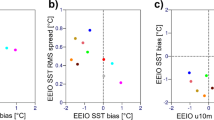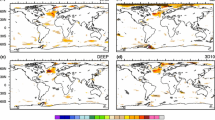Abstract
Coupled prediction systems for seasonal and inter-annual variability in the tropical Pacific are initialized from ocean analyses. In ocean initial states, small scale perturbations are inevitably smoothed or distorted by the observational limits and data assimilation procedures, which tends to induce potential ocean initial errors for the El Nino-Southern Oscillation (ENSO) prediction. Here, the evolution and effects of ocean initial errors from the small scale perturbation on the developing phase of ENSO are investigated by an ensemble of coupled model predictions. Results show that the ocean initial errors at the thermocline in the western tropical Pacific grow rapidly to project on the first mode of equatorial Kelvin wave and propagate to the east along the thermocline. In boreal spring when the surface buoyancy flux weakens in the eastern tropical Pacific, the subsurface errors influence sea surface temperature variability and would account for the seasonal dependence of prediction skill in the NINO3 region. It is concluded that the ENSO prediction in the eastern tropical Pacific after boreal spring can be improved by increasing the observational accuracy of subsurface ocean initial states in the western tropical Pacific.














Similar content being viewed by others
References
Balmaseda MA, Davey MK, Anderson DLT (1995) Decadal and seasonal dependence of ENSO prediction skill. J Clim 8:2705–2715
Balmaseda MA, Mogensen K, Weaver AT (2013) Evolution of the ECMWF ocean reanalysis system ORAS4. Q J R Meteorol Soc 139:1132–1161
Behringer DW (2007) The global Ocean data assimilation system (GODAS) at NCEP. In: 11th Symp. on integrated observing and assimilation systems for atmosphere, oceans, and land surface. Am. Meteor. Soc., San Antonio. Available online at https://ams.confex.com/ams/pdfpapers/119541.pdf
Behringer DW, Ji M, Leetmaa A (1998) An improved coupled model for ENSO prediction and implications for ocean initialization. Part I: the ocean data assimilation system. Mon Weather Rev 126:1013–1021
Bjerknes J (1969) Atmospheric teleconnections from the equatorial Pacific. Mon Weather Rev 97:163–172
Boyd JP (2005) The short-wave limit of linear Equatorial Kelvin waves in a shear flow. J Phys Oceanogr 35:1138–1142
Chen D, Cane MA, Kaplan A, Zebiak SE, Huang D (2004) Predictability of El Nino over the past 148 years. Nature 428:733–736
Delcroix T, Picaut J, Eldin G (1991) Equatorial Kelvin and Rossby Waves evidenced in the Pacific Ocean through Geosat sea level and surface current anomalies. J Geophys Res 96:3229–3262
Delworth T et al (2012) Simulated climate and climate change in the GFDL CM2.5 high-resolution coupled climate model. J Clim. doi:10.1175/JCLI-D-11-00316.1
Derber JD, Rosati A (1989) A global oceanic data assimilation system. J Phys Oceanogr 19:1333–1347
Deser C et al (2012) ENSO and Pacific decadal variability in the Community Climate System Model version 4. J Clim 25:2622–2651
Duan W, Wei C (2013) The ‘spring predictability barrier’ for ENSO predictions and its possible mechanism: results from a fully coupled model. Int J Climatol 33:1280–1292. doi:10.1002/joc.3513
Duan WS, Liu XC, Zhu KY, Mu M (2009) Exploring the characteristic of initial errors that cause a significant “spring predictability barrier” for El Nino events. J Geophys Res. doi:10.1029/2008JC004925
Ericksen CC, Blumenthal MB, Hayes HP, Ripa P (1983) Wind-generated Equatorial Kelvin waves observed across the Pacific Ocean. J Phys Oceanogr 13:1622–1640
Eriksen CC (1982) Equatorial wave vertical modes observed in a western Pacific island array. J Phys Oceanogr 11:48–70
Gill A (1982) Atmosphere-ocean dynamics. Academic, USA
Griffies SM, Hallberg RW (2000) Biharmonic friction with a Smagorinsky-like viscosity for use in large-scale eddy-permitting ocean models. Mon Weather Rev 128:2935–2946
Hackert E, Ballabrera-Poy J, Busalacchi AJ, Zhang RH, Murtugudde R (2007) Comparison between 1997 and 2002 El Ninõ events: role of initial state versus forcing. J Geophys Res. doi:10.1029/2006JC003724
Harrison DE, Vecchi GA (2001) El Niño and La Niña—equatorial Pacific thermocline depth and sea surface temperature anomalies, 1986–98. Geophys Res Let. doi:10.1029/1999GL011307
Hoerling MP, Kumar A (2002) Atmospheric response patterns associated with tropical forcing. J Clim 15:2148–2203
Ji M, Behringer DW, Leetmaa A (1998) An improved coupled model for ENSO prediction and implications for ocean initialization. Part II: the coupled model. Mon Weather Rev 126:1022–1034
Jin FF (1997) An Equatorial ocean recharge paradigm for ENSO. Part I: conceptual model. J Atmos Sci 54:811–829
Kessler WS, McPhaden MJ, Weickmann KM (1995) Forcing of intraseasonal Kelvin waves in the equatorial Pacific. J Geophys Res 100:10613–10631
Kirtman BP et al (2014) The North American Multimodel Ensemble. Phase-1 Seasonal-to-interannual prediction; phase-2 toward developing intraseasonal prediction. Bull Am Meteorol Soc 95:585–601
Kumar A, Hoerling MP (1995) Prospects and limitations of seasonal atmospheric GCM predictions. Bull Am Meteorol Soc 76:335–345
Kumar A, Siegfried SD, Suarez MS (2003) Variability and predictability of 200-mb seasonal mean heights during summer and winter. J Geophys Res. doi:10.1029/2002JD002728
Large WG, McWilliams JC, Doney SC (1994) Oceanic vertical mixing: a review and a model with a nonlocal boundary layer parameterization. Rev Geophys 32:363–403
Larson SM, Kirtman BP (2015) Revisiting ENSO coupled instability theory and SST error growth in a fully coupled model. J Clim 28:4724–4742
Latif M, Anderson D, Barnett T, Cane M, Kleeman R, Leetmaa A, O’Brien J, Rosati A, Schneider E (1998) A review of the predictability and prediction of ENSO. J Geophys Res 103(C7):14375–14393. doi:10.1029/97JC03413
Lau NC (1996) Interactions between global SST anomalies and the midlatitude atmospheric circulation. Bull Am Meteorol Soc 77:21–33
Lee HC, Rosati A, Spelman MJ (2006) Barotropic tidal mixing effects in a coupled climate model: oceanic conditions in the Northern Atlantic. Ocean Modell 11:467–477
Levin AFZ, McPhaden MJ (2015) The annual cycle in ENSO growth rate as a cause of the spring predictability barrier. Geophys Res Lett 42:5034–5041. doi:10.1002/2015GL064309
Long B, Chang P (1990) Propagation of an Equatorial Kelvin wave in a varying thermocline. J Phys Oceanogr 20:1826–1841
Madden RA (1976) Estimates of the natural variability of time-averaged sea-level pressure. Mon Weather Rev 104:942–952
McCreary J (1976) Eastern tropical ocean response to changing wind systems: with application to El Nino. J Phys Oceanogr 6:632–645
McPhaden MJ (2003) Tropical Pacific Ocean heat content variations and ENSO persistence barriers. Geophys Res Lett. doi:10.1029/2003GL016872
Meehl GA, Gent PR, Arblater JM, Otto-Bliesner BL, Brady EC, Graig A (2001) Factors that affect the amplitude of El Nino in global coupled climate models. Clim Dyn 17:515–526
Meinen C, McPhaden MJ (2000) Observations of warm water volume changes in the Equatorial Pacific and their relationship to El Nino and La Nina. J Clim 13:3551–3559
Merryfield WJ et al (2013) The Canadian seasonal to interannual prediction system. Part I: models and initialization. Mon Weather Rev 41:2910–2945
Molteni F, Stockdale T, Balmaseda M, Balsamo G, Buizza R, Ferranti L, Magnusson L, Mogensen K, Palmer T, Vitart F (2011) The new ECMWF seasonal forecast system (System 4). ECMWF Techn Memo 656, ECMWF, Reading, UK
Penny S, Behringer DW, Carton JA, Kalnay E (2015) A hybrid global ocean data assimilation system at NCEP. Mon Weather Rev 143:4660–4677
Philander SGH (1979) Equatorial waves in the presence of the Equatorial undercurrent. J Phys Oceanogr 9:254–262
Reynolds RW, Bayner NA, Smith TM, Stokes DC, Wang W (2002) An improved in situ and satellite SST analysis for climate. J Clim 15:1609–1625
Rosati A, Miyakoda K, Gudgel R (1997) The impact of ocean initial conditions on ENSO forecasting with a coupled model. Mon Weather Rev 125:754–772
Saha S et al (2010) The NCEP climate forecast system reanalysis. Bull Am Meteorol Soc 91:1015–1057
Saha S et al (2014) The NCEP climate forecast system version 2. J Clim 27:2185–2208
Shukla K et al (2000) Dynamical seasonal prediction. Bull Am Meteorol Soc 81:2593–2606
Wang XL, Zwier FW (1999) Interannual variability of precipitation in an ensemble of AMIP climate simulations conducted with the CCC GCM2. J Clim 12:1322–1335
Webster PJ, Yang S (1992) Monsoon and ENSO: Selectively interactive systems. Q J R Meteorol Soc 118:877–926
Wunch C, Gill AE (1976) Observations of equatorially trapped waves in Pacific sea level variations. Deep-Sea Res 23:371–390
Xue Y, Cane MA, Zebiak SE (1997) Predictability of a coupled model of ENSO using singular vector analysis. Part I: optimal growth in seasonal background and ENSO cycles. Mon Weather Rev 125:2043–2056
Yu JY, Kao HY (2007) Decadal changes of ENSO persistence barrier in SST and ocean heat content indices: 1958–2001. J Geophys Res. doi:10.1029/2006JD007654
Yu X, McPhaden MJ (1999) Seasonal variability in the equatorial Pacific. J Phys Oceanogr 29:925–947
Yu Y, Mu M, Duan W (2012) Does model parameter error cause a significant ‘‘Spring Predictability Barrier’’ for El Nino events in the Zebiak–Cane model? J Clim. doi:10.1175/2011JCLI4022.1
Zebiak SE, Cane M (1987) A model El Nino–Southern Oscillation. Mon Weather Rev 115:2262–2278
Zhu J, Kumar A, Huang B (2015) The relationship between thermocline depth and SST anomalies in the eastern equatorial Pacific: seasonality and decadal variations. Geophys Res Lett 42:4507–4515. doi:10.1002/2015GL064220
Acknowledgements
The support offered by the NOAA Climate Program Office for HC Lee is gratefully acknowledged. We thank Drs. Suranjana Saha and David Behringer for helpful comments and supports. Comments from the anonymous reviewer were very constructive for the final version of this manuscript and we appreciate for that.
Author information
Authors and Affiliations
Corresponding author
Appendix: Model climatology
Appendix: Model climatology
In order to compare the model climatology of CFSv2L, the control runs of CFSv2 and CFSv2L are carried out for 33 years. The control run of CFSv2 starts from the initial conditions of January 1st 1979 with the same model configurations of the operational NCEP CFSv2 (Saha et al. 2014). At the sea surface boundary, temperature and salinity fields of CFSv2 are weakly relaxed to the climatology by the 1000 day e-folding time scale. In CFSv2L, the control run starts from January 1st 1980 initial conditions and has no relaxation at the sea surface. Figure 15 shows sea surface temperature (SST) and salinity (SSS) differences between CFSv2L and CFSv2 (CFSv2L-CFSv2). The lower panels of Fig. 15 show the differences of standard deviation for monthly anomaly of SST and SSS. The anomaly is calculated from the monthly annual mean for 33 year results of each run.
Figure 16 shows differences of annual mean temperature between CFSv2L and CFSv2 (upper panel), and difference of standard deviation of monthly temperature anomaly over 33 years. Along the equator, the vertical gradient of thermocline in CFSv2 is a slightly larger than the one of CFSv2L, even though the reduced vertical background diffusivity of CFSv2L could strengthen the thermocline. It is expected that the reduced horizontal resolution in CFSv2L would tend to weaken the vertical gradient of thermocline, especially in the east–west slope in thermocline with seasonal fluctuation. This difference of the thermocline can also affect patterns of ENSO variability (Meehl et al. 2001).
Rights and permissions
About this article
Cite this article
Lee, HC., Kumar, A. & Wang, W. Effects of ocean initial perturbation on developing phase of ENSO in a coupled seasonal prediction model. Clim Dyn 50, 1747–1767 (2018). https://doi.org/10.1007/s00382-017-3719-5
Received:
Accepted:
Published:
Issue Date:
DOI: https://doi.org/10.1007/s00382-017-3719-5






